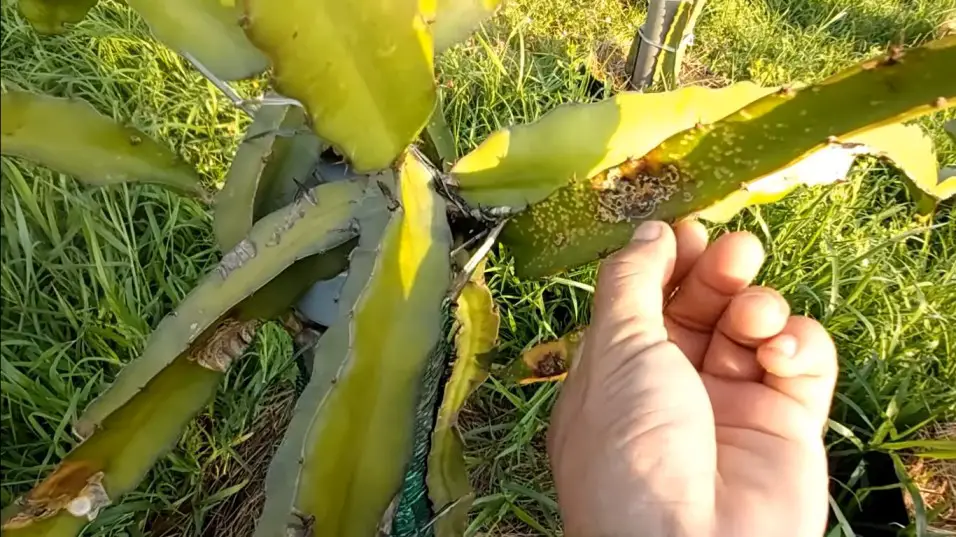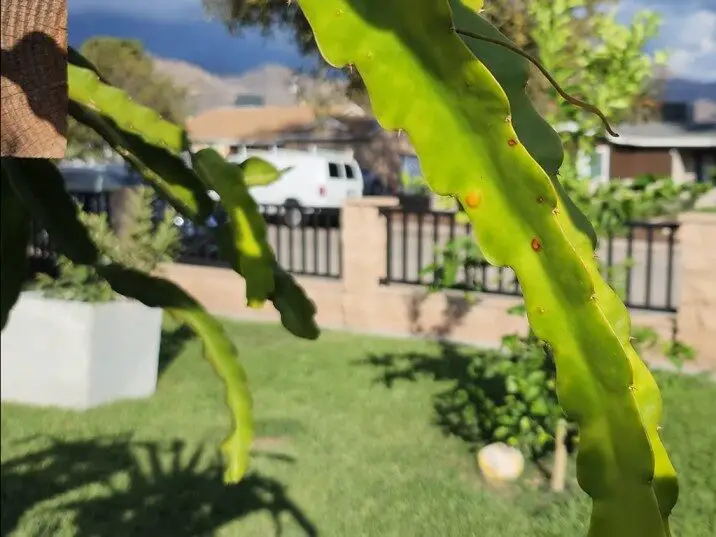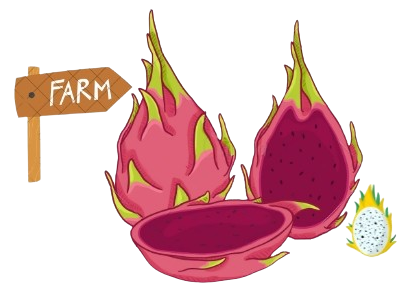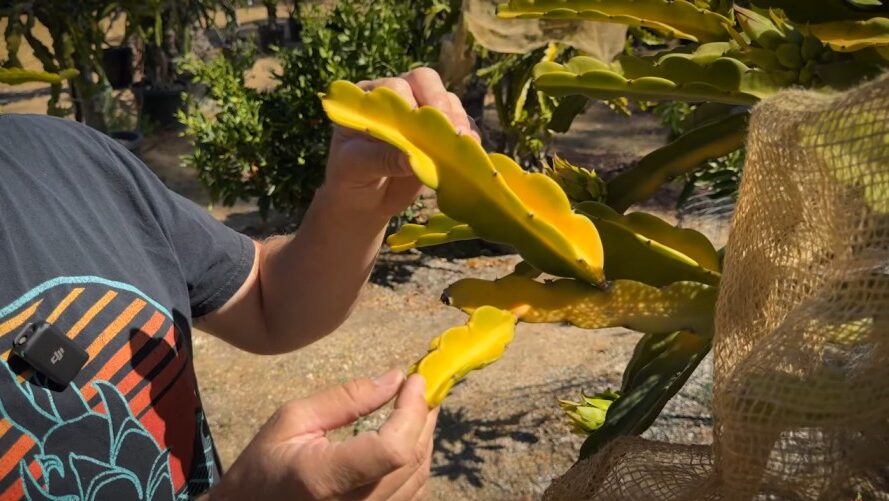Dragon fruit, also known as Pitaya, is a tropical and subtropical fruit known for its vibrant pink skin and unique taste. However, growing this fruit in regions like Himachal Pradesh, where winters can be extremely cold and unpredictable, poses several challenges, particularly with controlling dragon fruit fungus. As a farmer or hobbyist grower, understanding the environmental conditions, symptoms, and treatments for various types of red dragon fruit fungus is crucial to ensure the health of your plants year-round.
The Challenges of Growing Dragon Fruit in Himachal Pradesh

Himachal Pradesh, with its fluctuating temperatures and varied weather conditions, creates unique conditions for dragon fruit fungus to thrive. The biggest hurdles occur during the transition from summer to winter, the chilly winter months, and the monsoon season.
1. Winter Stress and Dragon Fruit Fungus
During the winter season, the dragon fruit plant undergoes a transition stress due to sudden temperature changes. As temperatures drop, the plants are more susceptible to fungal infections. The dragon fruit fungus thrives in this stressed environment, making winter one of the most critical times to manage fungal problems.
Symptoms of fungal infections during winter include:
- White spots on the leaves.
- Brown rust patches on stems and branches.
- Yellowing and wilting of leaves. If left unchecked, these fungal infections can severely damage the plant and prevent healthy fruit production.
2. The Impact of Winter Rain
Winter rains in Himachal Pradesh increase the humidity levels, creating a conducive environment for the spread of red dragon fruit fungus. Wet conditions combined with low temperatures make the plant more vulnerable to root rot, mold, and other fungal diseases.
Fungal Problems in Winter:
- Root rot can affect the plants as excess moisture prevents the roots from getting proper airflow.
- Anthracnose (Colletotrichum gloeosporioides) can cause black or brown spots on the fruit and stems, especially when there’s high humidity.
Common Types of Dragon Fruit Fungus

Understanding the different types of dragon fruit fungus that can affect your plants is vital to proper treatment. Some of the most common fungal infections in dragon fruit are:
1. Brown Rust (Contact Fungus)
One of the most prevalent fungal infections in dragon fruit plants, brown rust starts as small, orange-brown spots on the leaves. If not treated promptly, these spots will spread across the plant, causing severe damage to the stems and leaves. This fungus can weaken the plant, hindering its growth and fruit production.
Treatment:
To treat brown rust, a contact fungicide like Saaf or M-45 is recommended. Spraying the plant every 15 days during winter can significantly reduce the spread of this fungus.
2. White Spots (Powdery Mildew or Leaf Spot Disease)
White, powdery spots on the leaves are a typical sign of red dragon fruit fungus caused by fungal spores. This infection is particularly common during the monsoon and winter transition.
Treatment:
A systemic fungicide like Copper Oxychloride can help control this type of infection. Regular spraying during the rainy season can keep the infection in check.
3. Anthracnose
Anthracnose is a severe fungal disease that affects both the fruit and the stems of the plant. It appears as dark, sunken spots on the fruit, which eventually lead to rot. If the fungus spreads to the stems, it causes lesions and slow plant growth.
Treatment:
For anthracnose, using a combination of copper fungicides and hydrogen peroxide can be effective in curbing its spread. Ensure that you apply these treatments to the entire plant, including the roots.
Identifying the Symptoms of Dragon Fruit Fungus

Recognizing the signs of dragon fruit fungus early is crucial to preventing widespread damage. Here are the common symptoms to watch out for:
- Discolored or yellowing leaves: Fungal infections can cause the leaves to lose their green color and turn yellow.
- Brown or black spots: These can be an indication of red dragon fruit fungus or anthracnose.
- Soft or rotting stems: Fungal rot will often start at the tips or lower parts of the plant.
- Fruiting issues: If you notice fruit with unusual discoloration, cracks, or spots, it could be due to fungal infection.
How to Treat Dragon Fruit Fungus
1. Fungicide Treatment Schedule: Fungicides play a vital role in controlling dragon fruit fungus. However, it’s essential to follow the correct treatment schedule to avoid overdosing and causing stress to the plant. Below is an effective dragon fruit fungus treatment schedule:
- Lagaam: 2-3 ml per liter of water.
- Copper Oxychloride: 2 grams per liter.
- Nativo: 0.5-1 gram per liter or Spectrum Fungicide: 1 gram per liter.
- Saaf and M45: 2 grams per liter.
Apply these treatments every 15 days during winter, especially after rainfall. If there’s a lot of rain, spray once more after the water has drained and the soil has dried.
2. Organic Fungicides: If you prefer organic treatments, Neem oil and Trichoderma can be used for early-stage fungal infections. These natural solutions are effective and help to maintain the ecological balance of the farm.
- Neem oil: Spray once a month to keep pests and fungus under control.
- Trichoderma: A bio-fungicide, great for strengthening the plant’s resistance to fungal attacks.
Preventing Dragon Fruit Fungus: Best Practices
1. Pruning and Sanitation
To reduce the risk of fungal infections, regular pruning is essential. Remove any infected leaves, stems, or fruit immediately to prevent the fungus from spreading. Sanitize pruning tools to avoid transferring fungal spores to healthy parts of the plant.
2. Proper Watering and Drainage
Avoid overwatering and ensure the soil has proper drainage. Dragon fruit plants do not like standing water, and excessive moisture can lead to fungal infections like root rot.
3. Adequate Sunlight
Dragon fruit plants need a lot of sunlight to remain healthy. Ensure that your plants are exposed to sunlight for at least 6 hours a day to help strengthen their immune system against dragon fruit fungus.
4. Disease-Resistant Varieties
If you’re starting a new dragon fruit farm, consider planting varieties that are more resistant to fungal infections. While no variety is completely immune, some types show better tolerance to fungal diseases.
Seasonal Challenges and Tips
Summer:
During summer, high temperatures combined with sporadic rain showers create an ideal environment for dragon fruit fungus to spread. In this season, maintaining soil moisture and reducing humidity around the plant is key. Use mulching to keep the soil moisture balanced and avoid fungal growth.
Monsoon:
Monsoon season brings heavy rainfall and humidity, which significantly increase the risk of red dragon fruit fungus. During this time, frequent fungicide spraying and ensuring good airflow around the plants are crucial steps for preventing fungal attacks.
Winter:
In winter, as temperatures drop, dragon fruit fungus becomes more problematic due to the plants’ weakened immune system. Proper care, reduced watering, and applying fungicides at regular intervals will help the plants stay healthy through the cold months.
Conclusion
Managing dragon fruit fungus in Himachal Pradesh requires a proactive and seasonal approach. Each season brings its own set of challenges, but by understanding the types of dragon fruit fungus and following a regular treatment schedule, you can ensure that your plants stay healthy and productive. Whether it’s the stress from winter weather, the rainy monsoon season, or the hot summer months, providing consistent care and treatment will help you protect your investment and enjoy a bountiful harvest year-round.
Remember, early identification, regular treatment, and preventative measures are key to managing dragon fruit fungus effectively. By following these practices, you can keep your pink dragon fruit farm thriving in the challenging conditions of Himachal Pradesh.
If You have any other question regarding this or – how to treat dragon fruit fungus do let me comment down below


3 thoughts on “How to Control Dragon Fruit Fungus in Himachal Pradesh: An Essential Seasonal Guide”